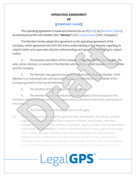Media Consent and Release Forms: Why Every Company Needs One
Picture this: you’re a business owner, and you’ve just wrapped up a fantastic marketing campaign featuring your clients’ success stories. You're...
6 min read
LegalGPS : Oct. 8, 2024
Ever wondered how you can protect your business from potential legal claims brought by employees? If so, you've likely come across terms like 'release of liability' and 'indemnification' agreement. Although these legal terminologies can seem overwhelming, as a responsible business owner, it's crucial to wrap your head around them. Don't worry -- we're here to make it easy for you!


Release of Liability and Indemnification Agreement (Employees)
Download our Release of Liability & Indemnification Agreement Template for Employees. Protect your business and ensure legal compliance effortlessly.
Trusted by 1,000+ businesses to safeguard their LLCs.
An employee release of liability and indemnification agreement is essentially a legal shield for your business. It's an agreement signed by your employees acknowledging they undertook specific risks associated with the tasks they perform at work. In case of any mishaps, the agreement protects the employer from any potential lawsuits.
Let's break it down further.
The 'release of liability' section covers scenarios where an employee might suffer harm due to the inherent risks involved in their job role -- think construction workers or professional stuntmen. The clause asserts the employee has knowledge of these risks and willingly agrees to bear them.
Often paired with release clauses, indemnification is an agreement that if any losses occur due to the specific actions of the employee, they will compensate the employer for the damages they face. For instance, if an employee's negligence triggers a customer lawsuit, the indemnification agreement can protect the business from bearing the financial brunt.
Pro-tip: You should always have an attorney review your indemnification agreement to ensure it's valid and enforceable.
These clauses can be found in both pre-employment contracts and NDAs (as we'll discuss below). Essentially, they're agreements that prevent the employee from negatively speaking about their former or current employer -- which can protect both parties. For example, if you discover a former employee is badmouthing your company on social media after leaving, you can sue them for defamation.
Pro-tip: If you're looking to put a non-disparagement clause in your contract, make sure it's as specific and clear as possible. That way, there won't be any confusion about what is considered "negative" speech.
This part generally describes the activities covered under the agreement. It could range from general employment tasks to specific activities like company-hosted events or business-related travel. The scope of release will also include a description of what is not considered covered by the agreement. This can include anything from personal actions to activities that occur outside of work hours.
Pro-tip: If you're looking to get a release from an individual, it's best to have them sign a general release rather than a specific one. That way, if they end up doing something that isn't covered by the agreement, they won't be able to argue against it.
This clause is typically included to prevent an employee from claiming they were unaware of the potential risks involved in their job roles. This clause can be included in a release agreement, but it's important to note that it doesn't make the employer completely immune from liability. For example, if an employee is injured on the job and claims they were unaware of the risks involved in their role as an electrician, then this clause may not be effective.
Pro-tip: Include a list of common risks associated with the job and have the employee agree to them. For example, if you're hiring someone to work in construction, they should know that there's a chance of injury and be aware of any safety precautions they need to take.
Importance of Release Agreements in Business
This section specifies the state laws that will govern the agreement and the jurisdiction where any disputes arising under the agreement will be settled. If you're doing business in multiple states, this is a vital clause that you should include. It's also important to specify which state's laws will apply to the agreement if you're doing business only in one state.
Pro-tip: If your company does business in multiple states, then make sure to include an "as it may be amended from time to time" statement after each law and jurisdiction reference so that future changes can be made without having to rewrite the entire agreement.
Pro-tip: Know the laws and regulations that will apply to your situation before drafting an agreement. For example, if you're hiring someone to work in construction, they should know that there's a chance of injury and be aware of any safety precautions they need to take.
Writing an effective release of liability and indemnification agreement may seem like a daunting task, but it's simpler than it appears. Just follow these straightforward steps:
Start your agreement by clearly identifying the involved parties – the employee and the employer (your business). Make sure to include names, addresses, and contact information. Also, mention the agreement's purpose – to release liability and indemnify the employer.
This Release of Liability and Indemnification Agreement ("Agreement") is made and entered into by and between [Employee's Full Name] ("Employee") and [Business Name] ("Employer"), located at [Business Address]. The purpose of this Agreement is to have the Employee release liability and indemnify the Employer for certain activities related to their employment.Enumerate the job-specific activities the employee will perform and the potential risks involved. Be precise and comprehensive. This section is crucial, as it helps the employee understand what they're consenting to.
The Employee shall assume and acknowledge the risks associated with their employment, including but not limited to [list specific tasks and associated risks or potential dangers]. The Employee understands that these activities may involve potentially hazardous situations and willingly accepts all associated risks.


Legal GPS Pro
Protect your business with our complete legal subscription service, designed by top startup attorneys.
Write a clear and unambiguous release of liability clause. This section will explicitly state that the employee waives their right to sue the employer for injuries or damages incurred due to their job duties.
Employee, on behalf of themselves, their heirs, executors, administrators, and assigns, hereby releases, waives, discharges, and covenants not to sue the Employer, its officers, agents, or employees, from any and all liability, claims, or damages for personal injuries or property damage resulting from the Employee's employment by Employer and participation in the activities described herein.In this section, the employee commits to compensating the employer for any damages if they cause harm to others or the company due to their negligent actions.
Employee agrees to indemnify, defend, and hold harmless the Employer, its officers, agents, or employees from and against any and all claims, demands, actions, losses, liabilities, costs, and expenses (including reasonable attorneys' fees) arising from or related to the Employee's negligent or willful actions during their employment.Establish the state laws governing the agreement and the jurisdiction for dispute resolution.
This Agreement shall be governed by and construed in accordance with the laws of the State of [Your State]. Any disputes arising from this Agreement shall be resolved exclusively in the courts located within [Your County and State].Finish your agreement by including a signature line for both the employee and the employer (or authorized representative). Be sure to date the signatures to make the agreement legally binding.
IN WITNESS WHEREOF, the parties hereto have executed this Agreement on the date indicated below.[Employee's Full Name] [Authorized Representative's Full Name]_____________________________ _____________________________ Employee Signature Employer Signature_____________________________(Date)After drafting your release of liability and indemnification agreement, it's wise to consult a legal professional to verify its compliance with your jurisdiction's laws. Once your attorney gives you the green light, you can go ahead and present the agreement to your employees for their review and signature.
Get Your Release of Liability & Indemnification Agreement Template
with a Legal GPS Subscription
Legal language is often challenging to understand. While writing the agreement, make sure it's easy for employees with non-legal backgrounds to comprehend.
Templated agreements often fail to cover all potential risks. Personalize your agreements to fit your employees' roles.
For example, if you're hiring a marketing agency to handle social media for your company, make sure your agreement includes terms that cover how their employees will interact with followers on your behalf.

Release of Liability and Indemnification Agreement (Employees)
Download our Release of Liability & Indemnification Agreement Template for Employees. Protect your business and ensure legal compliance effortlessly.
Trusted by 1,000+ businesses to safeguard their LLCs.
If you're working with an outside vendor or contractor who's not an employee of yours, make sure they sign a separate contract before beginning work.
This will help you avoid some of the legal issues associated with vicarious liability.
A template agreement is fine for many types of work, but it's not always appropriate. If you're working on an ongoing project with another company where changes are likely, consider creating a separate contract for each one. This will help ensure that all parties are aware of their responsibilities and requirements every step of the way.
Entrepreneurs can undoubtedly draft agreements themselves. However, using a professional template ensures that:
You are following state and national laws;
You save valuable time and resources;
You minimize potential disputes and resulting litigation.
There you have it! All the essentials about 'Release of Liability & Indemnification Agreements for Employees'. Now, it's essential to inform your employees about the agreement adequately and seek their consent in a non-coersive environment. Want to ensure your business is on the right legal track? Consider using our professional contract template to mitigate risks.
The biggest question now is, "Do I need a business lawyer?” For most businesses and in most cases, you don't need a lawyer to start your business. Instead, many business owners rely on Legal GPS Pro to help with legal issues.
Legal GPS Pro is your All-In-One Legal Toolkit for Businesses. Developed by top startup attorneys, Pro gives you access to 100+ expertly crafted templates including operating agreements, NDAs, and service agreements, and an interactive platform. All designed to protect your company and set it up for lasting success.
Get Legal GPS's Release of Liability & Indemnification Agreement Template Now

Legal GPS Pro
Protect your business with our complete legal subscription service, designed by top startup attorneys.
|
Premium Template
Single-use Template |
Legal GPS Pro
Unlimited Access, Best Value |
|
|
| Choose Template | Learn More |
| Trusted by 1000+ businesses | |
Table of Contents

Picture this: you’re a business owner, and you’ve just wrapped up a fantastic marketing campaign featuring your clients’ success stories. You're...

If you're a personal trainer or involved within the fitness industry, you know that maintaining a strong reputation and offering a seamless service...

Have you ever been in a photoshoot and wondered how to manage things legally, to ensure you are adequately protected while also protecting the rights...